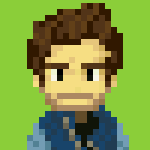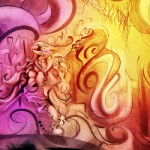 Add Review
Add Review Subscribe
Subscribe Nominate
Nominate Submit Media
Submit Media RSS
RSS
A benchmark for psychological RPGs.
 S32
S32- 02/15/2013 05:23 AM
- 2082 views
WARNING: THIS REVIEW MAY CONTAIN SPOILERS
It's not often that I come across a homebrew game that grips me in the way that "The Longing Ribbon" does. The game is already roughly 7 years old, but I found that the experience it delivers is timeless. Of course, no game can be perfect; "The Longing Ribbon" has its downsides, but none that too harshly soured the overall experience.
Instead of reviewing specific aspects of the game, I will be taking my own approach, in which I categorize the game's most notable aspects in terms of excellence. Hopefully it will allow you to easier understand what works and what doesn't, without having to adhere to specific categories and guidelines.
That said, without further ado:
FIVE STAR FEATURES (★★★★★)
FOUR STAR FEATURES (★★★★)
THREE STAR FEATURES (★★★)
TWO STAR FEATURES (★★)
ONE STAR FEATURES (★)
SPECIAL ACCOLADES
CROWNING ACHIEVEMENT: The atmosphere, by far. This game's environment will pull you in and won't let go.
BIGGEST BLUNDER: The combat system. Honestly, I don't see why this game even needed it. At most, a time-sensitive "hit this button to dodge X thing" system would have sufficed.
S32'S FAVORITE FEATURE: The piano. Oh my dear lord. I played with this thing every chance I got. I spent at least 20 minutes trying to play Jingle Bells, Joy To The World, even The Exorcist theme. Sometimes the little things make all the difference.
FINAL THOUGHT
Overall, "The Longing Ribbon" is one of my favorite homebrew RPGs to date. I can't think of another game like it, and unique games are the ones I remember (so long as they're also fun). I'm glad I was able to finish it, and despite its flaws, I highly recommend it.
4.5/5
It's not often that I come across a homebrew game that grips me in the way that "The Longing Ribbon" does. The game is already roughly 7 years old, but I found that the experience it delivers is timeless. Of course, no game can be perfect; "The Longing Ribbon" has its downsides, but none that too harshly soured the overall experience.
Instead of reviewing specific aspects of the game, I will be taking my own approach, in which I categorize the game's most notable aspects in terms of excellence. Hopefully it will allow you to easier understand what works and what doesn't, without having to adhere to specific categories and guidelines.
That said, without further ado:
FIVE STAR FEATURES (★★★★★)
- The atmosphere. Everyone who plays this game rants and raves about how well-established the atmosphere is in this game - and they're right. At first, I wasn't too sure what to think about the use of pre-packaged RTP tiles and sprites in what was supposed to be a psychological thriller, but as the game progressed I quickly abandoned my skepticism. By way of the music choices, sound cues, and lighting (RGB screen tone, mind you), it wasn't long before I was completely consumed. There were times where I could almost feel myself within the walls of the spooky manor, and that level of immersion is definitely worth the greatest of accolades.
- The audio. As I mentioned above, the audio is what really set the mood in this game. The use of the slow tracks to portray a cold, unnerving atmosphere, as well as the faster, heavier tracks used to get your heart racing, set the mood perfectly. All of the sound queues were on point; the pouring rain, doors slamming behind you, muffled voices coming through the walls, howling in the distance, etc. Although the game's atmosphere stands on many legs, it would suffer without the attention to audio.
FOUR STAR FEATURES (★★★★)
- The cinematics. When dealing with 2D RPGs (especially homebrew), good cinematics are often hard to create, and even harder to make convincing. Gibmaker made great use of the limited technology RM2K offered, through character movement and overlaying pictures. There were times when the character movement felt a little clunky, and some of the action scenes are limited to your standard "turn the hero to the left and play a sword slash battle animation over the target" fare, but not so bad as to kill the atmosphere.
- The characters. Although you only control one character for the majority of the game, there are a variety of interesting characters that you must interact with over the course of the game. Some characters were made very believable through subtleties in dialogue and character development (I loved Lyman's nervous, passive mannerisms), though others weren't touched on that much, and seemed to only be driven by story arcs. Still, the character interaction made believable human beings out of the lot of them.
- The dialogue. As I mentioned above, many of the game's characters are fleshed out through the use of clever and convincing dialogue. I found it easy to identify with most characters and learn their mannerisms through the way they spoke to one another. I found myself laughing at the wit of certain characters, but also intrigued by others, both of which I felt were at the right times. You are presented by many dialogue choices throughout the game, influencing the way that scenes play out. This adds some definite replay value for more playthroughs, though some of the choices are just so ridiculous that you can't help but abandon your unease to chuckle for a bit.
THREE STAR FEATURES (★★★)
- The graphics. Don't get me wrong, Gibmaker made excellent use of what he had. The map design almost makes you forget that you're trapped in a house composed of RTP chips and sprites - but not quite. In my opinion, RTP graphics have been enough games that their inclusion in this original game stole away from its uniqueness. The cheesy picture frame tiles on the walls, the stock battle animations popping up in action scenes, and looking upon characters like Luke I found myself thinking, "Oh, hey Alex." Looking at the older versions of some of the maps, I can see Gibmaker made an effort to shy away from the pre-packaged tilesets by meshing them together with newer stuff (eg. Mack and Blue), though I felt he could have gone a little further. Some of the picture overlays also suffered from RM2K's transparency limitations, though that's certainly not Gibmaker's fault.
- The story. The game's story is developed very well through the first half of the game, as you learn the secret behind the manor, where those voices are coming from, and what's up with the possessed kid. However, it starts to wane a little bit in the second half, when the game is suddenly about 2 demons fighting each other and using the characters as pawns. Gibmaker said himself that he was in something of a rush to finish it, and you can sort of tell from how the game wraps up. It can be hard to juggle so many elements of a game by yourself, but considering it's an RPG, I think a little more attention to the story would have helped.
TWO STAR FEATURES (★★)
- The leveling/advancement system. At first, gaining stats through observing paintings and reading literature felt like one of the coolest ideas ever. However, it became evident that if you don't take the time to explore every nook and cranny, it hinders you greatly in the future. You can upgrade at sinks in every chapter to upgrade anything - stats, skills, and skill proficiency - which is decent enough on paper, but should you miss a sink in a chapter for any reason, you basically forfeit the upgrade. Considering how difficult the combat is (I'll get to that in due time), not getting an upgrade, or upgrading the wrong thing, can actually mean not being able to progress. That's not good, especially when the game's events are what is driving the player forward.
- The puzzles. Although the puzzles are somewhat interesting, there is very little explanation on how to do them. In some cases you get a vague hint as to what you're supposed to, but for the most part, you're entirely on your own. Hard puzzles aren't bad in theory, but when you don't have the option between hard and easy puzzles, not giving the player something to go on is kind of a dick move. Players who are not familiar with piano keys will have a hell of a time.
ONE STAR FEATURES (★)
- The combat system. With all due respect to Gibmaker and his efforts, fuck the combat system in this game. In conjunction with how easy it is to screw up your stats through the advancement system, combat is the ultimate roadblock. You are restricted to tiny health/MP bars that you can barely see, leaving you no way of knowing how much health you really have, or how much damage you're suffering. This much guesswork when there's a chance of an instant game over is bad design. The combat is not spread out evenly throughout the game; at times you'll never have a single fight, and other times there will be nonstop back-to-back fights. All in all, the combat is much more of a hindrance than anything else.
- Save points. In this game, not only are save points are scarce, but they also expire! That's right, once you've used a save point, it's gone forever. If you made a bit of progress on a particularly taxing puzzle and want to save, you're SOL. The worst part, however, is how inopportunely some of the save points are placed. Nothing makes me ragequit quite like loading a save, sitting through 5 minutes of dialogue, making my way down a maze-like corridor, getting killed by something I didn't know how to avoid, and having to start all over. Like most people, I had to cheat to deal with the combat, but through poking around at the game files, I also made an additional cheat of my own that allowed me to save whenever I wanted. Sorry Gibmaker, but it was necessary.
SPECIAL ACCOLADES
CROWNING ACHIEVEMENT: The atmosphere, by far. This game's environment will pull you in and won't let go.
BIGGEST BLUNDER: The combat system. Honestly, I don't see why this game even needed it. At most, a time-sensitive "hit this button to dodge X thing" system would have sufficed.
S32'S FAVORITE FEATURE: The piano. Oh my dear lord. I played with this thing every chance I got. I spent at least 20 minutes trying to play Jingle Bells, Joy To The World, even The Exorcist theme. Sometimes the little things make all the difference.
FINAL THOUGHT
Overall, "The Longing Ribbon" is one of my favorite homebrew RPGs to date. I can't think of another game like it, and unique games are the ones I remember (so long as they're also fun). I'm glad I was able to finish it, and despite its flaws, I highly recommend it.
4.5/5

Posts 

Pages:
1
I played this a long time ago and loved it... The other day, I was sifting through all of the games I've downloaded and keep stored, and this caught my eye. I love this game. It was the first RPG Maker game I ever finished.
YOU REALLY TOLD THE COMBAT SYSTEM. I guess I agree. Oh well. GLAD IT STILL GOT 4.5/5 ANYWAY :}
author=Gibmaker
YOU REALLY TOLD THE COMBAT SYSTEM. I guess I agree. Oh well. GLAD IT STILL GOT 4.5/5 ANYWAY :}
I always strive to be honest, even if that honesty is overbearingly abrasive.
Also, the final score is a reflection of how much I enjoyed the game overall, rather than an average of how everything else stacked up.
Pages:
1
















